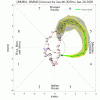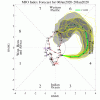Webberweather53
Meteorologist
The CMC ens has been colder than the other two for several days. Unfortunately, it carries the strongest cold bias for the E US of the 3 major ensembles. So, this may be a function of bias.
This isn't a function of its cold bias, the Canadian just simply has a better Pacific pattern than the other 2 model suites w/ a deeper more extensive trough over eastern Russia that nudges the GOA ridge eastward. It's important to look a little beyond these stereotypical biases to assess why "x" model is producing "y" solution. Could you argue this cold bias is a function of a more intrinsic model bias such as one that produces weaker GOA ridges and stronger Kamchatka lows? Maybe, but again that requires more in depth analysis than sweeping the model under the rug because it usually is "x" biased.

























